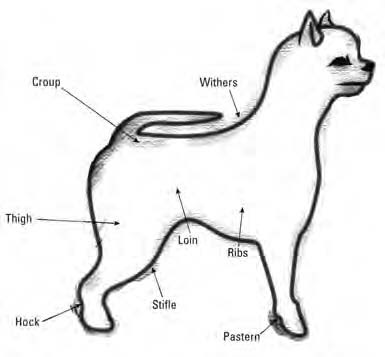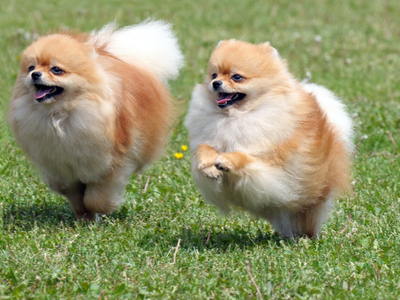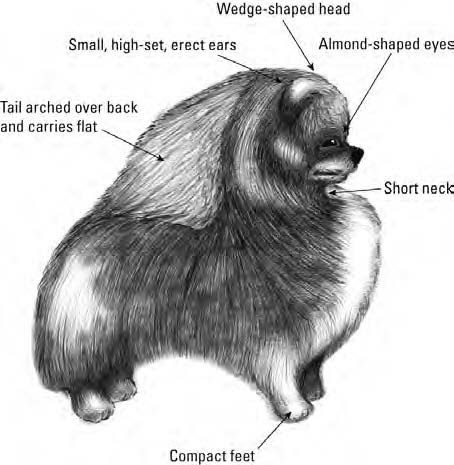In This Chapter
- Who’s your daddy: Identifying Pom details
- Sizing up the Pomeranian physique
- A meeting of the minds: The Pomeranian personality
- Recognizing Pom pluses and minuses
- Considering the costs: Dollars, time, and effort
Eyeing the Standard: The Pomeranian Blueprint
Technical Stuff
Periodically, the standard may change slightly to clarify certain points or even to make certain traits — like new colors that may have cropped up or extremes in sizes — more or less desirable. However, such changes are never made lightly. The American Pomeranian Club (APC) is responsible for safeguarding the Pom standard. The first APC standard was adopted in 1916; subsequent standards were adopted in 1935, 1960, 1980, 1991, and 1997 (the current version).
The gist of the Pom: General appearance
– A compact, short-backed toy dog
– A profuse outer coat and a plumed tail that lies flat on his back
– An active, alert, cocky, commanding, and inquisitive nature
From head to toes: Pom specifics
– Size, proportion, and substance: He’s a sturdy, medium-boned dog weighing 3 to 7 pounds (ideally, 4 to 6 pounds), slightly taller than long.
– Head: His expression is foxlike, with small, high-set, erect ears; he has dark, almond-shaped eyes of medium size and a rather short, fine, but not snippy, muzzle; the top of his skull is slightly rounded but not domed, and it doesn’t have a soft spot; his teeth meet in a scissors bite with the top incisors just barely in front of the bottom ones.
– Neck and Body: He carries his head proud and high; a short neck leads to a short, level back, which in turn leads to a tail that lies flat and straight on the back; the body is compact, with the ribcage meeting the elbows.
– Forequarters: His forelegs are straight and parallel to each other with strong, straight pasterns leading to well-arched, compact feet that point straight ahead; the length of his legs is such that his elbows are halfway between the ground and the highest point of his shoulder.
– Hindquarters: Viewed from behind, his legs are straight and parallel to each other; from the side, his buttocks are well behind the set of the tail; the knees are moderately bent, and the hocks are perpendicular to the ground; the well-arched, compact feet point straight ahead; as in the front, he stands mostly on his toes, not his heels.
– Gait: When he trots, his front legs reach well out in front and his rear legs push off with a strong drive, the whole impression being smooth, balanced, and vigorous. The faster he goes, the more his legs converge in a straight line toward a center line beneath his body.
– Coat: His coat is made up of two parts: a thick, soft, dense undercoat and a long, straight, glistening, harsh outer coat. The thick undercoat makes the outer hairs stand off from his body, giving him a puffball appearance. The coat is heaviest around the neck and the forepart of the chest and shoulders; it is shortest on the head and legs. The coat on the rear of his legs down to the pastern and hock is feathered; his tail is profusely covered with long, harsh, straight hair.
– Color: All colors and patterns are equal in desirability:
- Black and tan: The tan is rich and clearly defined over the eyes, on the muzzle, throat, and forechest, on all legs and feet, and below the tail.
- Brindle: The base color of gold, red, or orange has strong, black, vertical stripes.
- Parti-color: Colored areas appear on white; a white blaze is preferred.
– Temperament: He is extroverted, intelligent, and vivacious; a great companion and a competitive show dog.
Beneath the Fur: Pom Anatomy 101
– Your dog’s toes are his fingers.
– His hand, or pastern, is actually off the ground.
– His elbow is way up there almost to his chest.
His upper arm is next to his body.
– His shoulder blades reach up to form a high point above his spine; this point is called the withers.
– His heels (or hocks) are in his hind legs and are well off the ground.
– His knee is called a stifle.
– His lower back is called his croup.
Small Package, Big Personality
Great balls of fire!
Poms are full of energy, their little pistonlike legs moving in a blur as they rush from one place to the next. If Poms were big dogs, they’d travel miles every day and drive their people quite insane. Fortunately, they’re small, and even though they travel great distances, they can do it all inside your home by scurrying from room to room.
The Pomeranian genealogyPomeranians descend from one of the most ancient lines of domesticated dogs, the Spitz family. Spitz-type dogs were associated with hunter-gatherers at least 6,000 years ago. The Spitz have retained many of the traits that helped their ancestors (European wolves) survive in cold climates. They have thick, weather-resistant coats for warmth; small, furry ears that are less susceptible to heat loss and frostbite; a bushy tail to cover the nose when sleeping; and a muzzle of moderate length to warm incoming air. Over time, various subtypes of Spitz breeds developed according to the needs of the geographical regions. For example, some Spitz were used as sledge dogs, some as herders, and, last but not least, some smaller ones as house dogs whose main function was to sound the alarm at danger. Sound familiar? Little is known about the Pomeranian dog of long ago except that it was a Spitz dog weighing about 30 pounds, not the tiny darling we know today. The breed’s home country is Pomerania, in what is now part of northern Poland and Germany. Poms were prized pets not only in Pomerania but also throughout Europe, attracting notables such as Michelangelo, Mozart, and Isaac Newton. The Pomeranian came to Britain in 1767. In 1888, Queen Victoria spotted an especially small Pomeranian while she was on a trip to Florence, Italy. (Marco weighed only 12 pounds when most Pomeranians were weighing closer to 20 pounds.) She brought him home and exhibited him at an English dog show, thus setting the trend for smaller Poms. When specimens started to mature below 8 pounds, they were dubbed Toy Pomeranians. Marco was also a red sable at a time when most Poms were white, black, or white and black. But by the end of the 19th century, most Poms were small and red. Ah, the pull of royalty! By the beginning of the 20th century, Pomeranians were one of the most popular breeds registered or shown in England. The smaller size and greater variety of vivid colors did much to make the breed a dog of fashion that no well-dressed lady could be without. Poms were also catching on in America, although, without the royal example, the trend was a little bit slower. In 1888 the first Pom was entered into the American Kennel Club’s (AKC) stud book, and in 1892 the first one was exhibited at an American dog show. The AKC officially recognized the Pomeranian in 1900, the same year the Pomeranian Club of America was founded. The breed grew in popularity, becoming one of the ten most popular AKC breeds in the 1930s. It again entered the top ten in 1994, where it remained for many years. |
Remember
Nonetheless, don’t let their small size fool you into thinking you can ignore them. In a pinch they can exercise on their own, but they need the mental exercise that only you can provide. Without that stimulation, a Pom finds his own entertainment and challenges — and then exercises his mind by getting into trouble!
Cuddle-up pup
Perky and playful
Fit and fancy-free
It’s the SpitzPomeranians are the smallest of the dogs considered to be in the Spitz family. Spitz breeds tend to have wolflike or foxlike wedge-shaped heads, small ears, thick double coats, bushy tails curled over the back, and a stocky build. They are independent by nature. Other Spitz breeds include the Akita, Siberian Husky, American Eskimo Dog, and a host of others. |
Remember
Spitz dogs have always relied on their own thinking to get the job done. In the same tradition, Pomeranians don’t just sit around scratching their ears, waiting for your next command — they’re already acting out their own plan. As a result, Poms are constantly checking out new sights and don’t mind telling your company they’re not welcome. (Yes, they can be a little suspicious of strangers — it’s the Spitz way.) That’s why early socialization and training are vital for Pomeranians.
The little brainiac
Tip
Pomeranians are incredibly bright (although their independent nature means they often use their intelligence to get into mischief). And they won’t be bullied into compliance — their Spitz ancestry makes them too good at digging in their heels. That’s why positive, reward-based training methods work so well with them. When you convince your Pom that your way pays off for him, he becomes your apt and willing pupil. In fact, many Pomeranians have attained high honors in obedience trials, and they’re adept at picking up new tricks.
Bold and brash
Watchdog extraordinaire
Protection dog — not so much!
All Things Considered: The Pros and Cons of Poms
The not-so-great points
– Toy dogs can be seriously injured by jumping off of furniture, being dropped, or being stepped on.
– They can trip you easily.
– They’re too fragile for very young children to play with safely.
– They can’t go jogging with you, can’t get far hiking, can’t do a good job of protecting you, and can’t do some dog sports aimed at larger dogs.
– Housetraining can be more of a challenge in toy dogs compared to large dogs.
– They can be killed by larger dogs, wild predators, or even birds of prey.
– Poms in particular need attention to their coat.
– Poms can also bark a lot.
The great points
– Small dogs cost less to board, medicate, and generally care for.
– They can chew on one kibble like it’s a feast.
– Because less goes in, less comes out, and you aren’t faced with elephantine poop piles or puddles.
– You can carry a toy dog in a purse-sized bag and take her with you to places big dogs aren’t allowed.
– Busy schedules, small yards, and maybe a bit of laziness all make small dogs more appealing when you consider the exercising element.
– Small dogs don’t need to go outside in bad weather to get some exercise. On snowy days, you can play fetch, tag, or your own crazy games indoors!
– They don’t push you out of your bed or eat you out of house and home.
– They don’t drag you down the sidewalk, kill the neighbor’s cat, or jump through your windows to attack the mail carrier.
When you’ve decided a toy dog is just the ticket, you have so many breeds — Affenpinschers to Yorkshire Terriers — to choose from. So why a Pomeranian?
Uniqueness
– Poms are among the smallest of all the toy breeds.
– They’re among the more energetic and adventurous of toys.
– They enjoy meeting challenges and can succeed at many dog sports.
– Poms love to play, but they also enjoy cuddling.
Color varieties
Technical Stuff
The earliest Poms were white or sometimes black and white or solid black. When the red-sable Marco came on the scene (see the sidebar “The Pomeranian genealogy” for more on this guy), he aroused interest in other colors.








